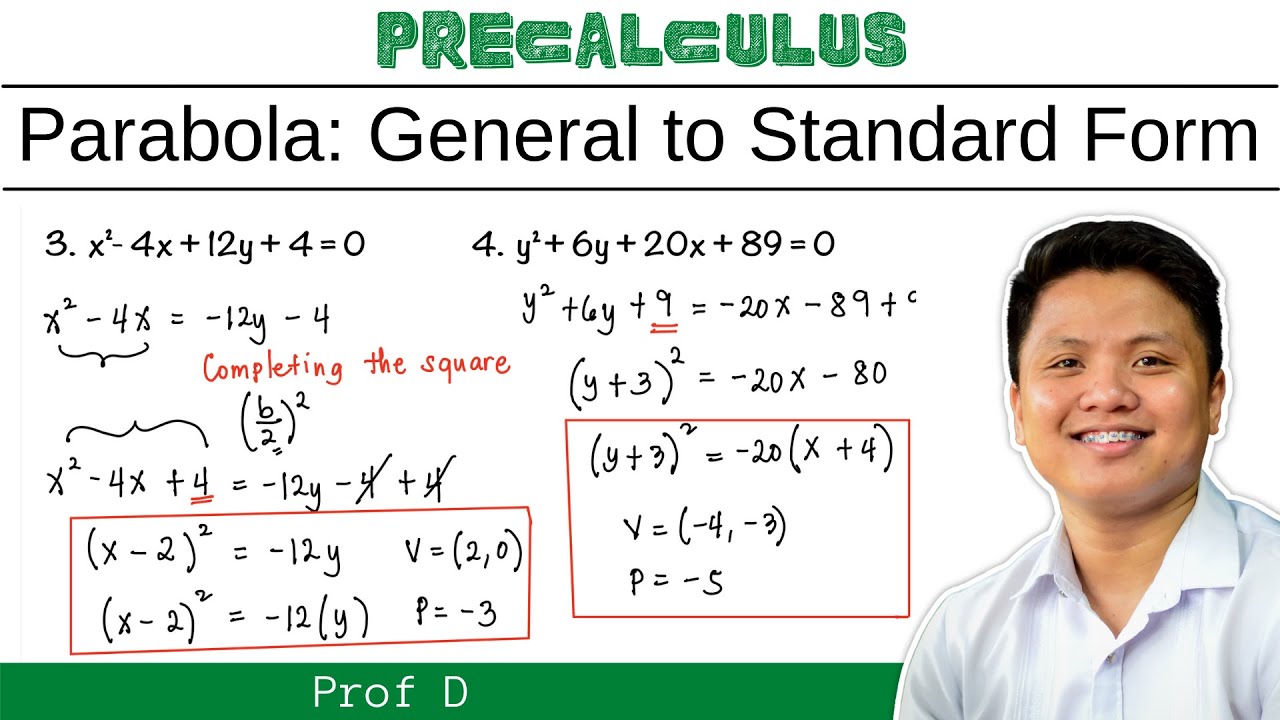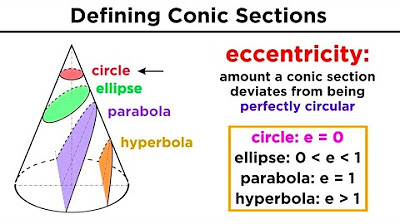DETERMINING IF AN EQUATION IS A CIRCLE, POINT, OR HAS NO GRAPH | PROF D
TLDRIn this educational video, viewers learn how to determine the nature of graphs represented by equations. The presenter introduces a formula involving coefficients 'd', 'e', and 'f' from the general form of a circle equation (x^2 + y^2 + dx + ey + f = 0). If the formula's result is greater than zero, the graph is a circle. If it equals zero, the graph is a point circle, and if it's less than zero, the equation has no graph. Three examples illustrate these concepts, with calculations showing whether each equation graphs a circle, a single point, or nothing at all. The video concludes with an invitation for questions and further discussion.
Takeaways
- 📚 The video explains how to determine if an equation represents a circle, a point circle, or has no graph.
- 🔍 The formula to use is \(d^2/4 + e^2/4 - f\), where \(d\), \(e\), and \(f\) are coefficients from the general form \(x^2 + y^2 + dx + ey + f = 0\).
- 👍 If the formula result is greater than zero, the graph is a circle.
- ⭕ If the formula result equals zero, the graph is a point circle.
- ❌ If the formula result is less than zero, the equation has no graph.
- 📝 Example 1: The equation \(x^2 + y^2 + 10y = 0\) results in a value of 25 for the formula, indicating a circle.
- 📝 Example 2: The equation \(x^2 + y^2 - 6x + 2y + 10 = 0\) results in a value of 0 for the formula, indicating a point circle.
- 📝 Example 3: The equation \(4x^2 + 4y^2 + 16x - 24y + 72 = 0\) results in a negative value for the formula, indicating no graph.
- 🔢 The value of \(d\), \(e\), and \(f\) are determined by identifying coefficients in the given equation.
- 📐 The process involves substituting the identified values into the formula and simplifying to get the final result.
- 👨🏫 The video is presented by Prof D, who encourages viewers to ask questions in the comments if they need clarification.
Q & A
What is the purpose of the video?
-The purpose of the video is to teach viewers how to determine whether a given equation represents a circle, a point circle, or has no graph at all.
What is the general form of the equation discussed in the video?
-The general form of the equation discussed is x^2 + y^2 + dx + ey + f = 0, where d, e, and f are constants.
What does the formula d^2/4 + e^2/4 - f represent in the context of the video?
-The formula d^2/4 + e^2/4 - f is used to determine the nature of the graph of the equation: a circle, a point circle, or no graph.
What does a positive result from the formula d^2/4 + e^2/4 - f indicate about the graph of the equation?
-A positive result indicates that the graph of the equation is a circle.
What does a result of zero from the formula d^2/4 + e^2/4 - f indicate about the graph of the equation?
-A result of zero indicates that the graph is a point circle, meaning it consists of a single point.
What does a negative result from the formula d^2/4 + e^2/4 - f indicate about the graph of the equation?
-A negative result indicates that the equation has no graph.
In the first example, what is the value of d, e, and f in the equation x^2 + y^2 + dx + ey + f = 0?
-In the first example, d is 0, e is 10, and f is 0.
What is the conclusion of the first example in the video?
-The conclusion of the first example is that the graph of the equation is a circle because the value from the formula is greater than zero.
In the second example, what are the values of d, e, and f?
-In the second example, d is -6, e is 2, and f is 10.
What is the conclusion of the second example in the video?
-The conclusion of the second example is that the graph of the equation is a point circle because the value from the formula is zero.
In the third example, what are the values of d, e, and f after simplifying the equation?
-In the third example, after simplifying, d is 4, e is -6, and f is 18.
What is the conclusion of the third example in the video?
-The conclusion of the third example is that the equation has no graph because the value from the formula is less than zero.
What does the instructor suggest doing if viewers have questions or need clarifications?
-The instructor suggests that viewers should leave their questions or clarifications in the comment section below the video.
Outlines
📚 Introduction to Circle Equation Analysis
The video begins with an introduction to the topic of analyzing equations to determine if they represent a circle, a point circle, or have no graph at all. The presenter introduces the misalignment formula, which is used to evaluate the graph of an equation. The formula is \( \frac{d^2}{4} + \frac{e^2}{4} - f \), where \( d \), \( e \), and \( f \) are coefficients from the general form of the equation \( x^2 + y^2 + dx + ey + f = 0 \). The video explains that if the formula's result is greater than zero, the graph is a circle; equal to zero, it's a point circle; and less than zero, the equation has no graph. The presenter then proceeds to work through example equations to demonstrate the application of the formula.
🔍 Analyzing Example Equations for Circle Graphs
In this section, the presenter works through several example equations to illustrate how to apply the misalignment formula. The first example equation is simplified to show that the graph is a circle, as the formula results in a positive number. The second example involves an equation where the values of \( d \), \( e \), and \( f \) are identified, and the formula is applied to conclude that the graph is a point circle, as the result is zero. The presenter also discusses the significance of the coefficients and how they relate to the shape of the graph, providing a clear explanation of the process.
📉 Example with No Graph and Video Conclusion
The final example in the video involves an equation where the coefficients are divided to simplify the terms and identify \( d \), \( e \), and \( f \). After applying the misalignment formula, the result is a negative number, indicating that the equation has no graph. The presenter wraps up the video by summarizing the outcomes of the examples and encouraging viewers to ask questions or seek clarifications in the comments section. The video concludes with a sign-off, indicating that further discussions will continue in future videos.
Mindmap
Keywords
💡Circle
💡Equation
💡Graph
💡D^2/4 + E^2/4 - F
💡Point Circle
💡No Graph
💡General Form
💡Coefficients
💡Example
💡Prof D
Highlights
Introduction to determining whether an equation represents a circle, point circle, or has no graph.
Explanation of the alignment formula: d^2/4 + e^2/4 - f.
If the formula result is greater than zero, the graph of the equation is a circle.
If the formula result is equal to zero, the graph is a point circle.
If the formula result is less than zero, the equation has no graph.
Example 1: Using the formula to determine if the equation x^2 + y^2 + dx + ey + f = 0 represents a circle.
Explanation of general form variables: d (x variable coefficient), e (y variable coefficient), and f (constant).
Substitution of values into the formula for Example 1, resulting in a positive number, indicating a circle.
Example 2: Determining the graph type for x^2 + y^2 - 6x + 2y + 10 = 0.
Identification of d, e, and f values and substitution into the formula, resulting in zero, indicating a point circle.
Example 3: Analysis of the equation 4x^2 + 4y^2 + 16x - 24y + 72 = 0.
Normalization of the equation by dividing all terms by 4 to match the general form.
Substitution of normalized values into the formula, resulting in a negative number, indicating no graph.
Summary of methods to determine the type of graph represented by an equation.
Closing remarks and invitation for questions or clarifications in the comment section.
Transcripts
Browse More Related Video

CIRCLE | TRANSFORMING GENERAL FORM TO STANDARD FORM | PROF D

CIRCLE | TRANSFORMING STANDARD FORM TO GENERAL FORM | PROF D

EQUATION OF CIRCLE IN STANDARD FORM | PROF D

Implicit Differentiation | Differentiation when you only have an equation, not an explicit function

Transforming General Form to Standard Form of Parabola | @ProfD

Graphing Conic Sections Part 1: Circles
5.0 / 5 (0 votes)
Thanks for rating: